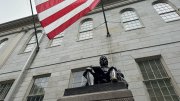A 117-page University report on sweatshop practices released in October criticized working conditions in factories that make Harvard-licensed apparel, but offered few easy solutions for improvement. The report (available via www.news.harvard.edu/-specials/apparelreport) came at the end of a yearlong investigation, conducted by several consulting groups, that was sponsored by Harvard and four other universities. The consultants found poor working conditions in all the countries studied--China, El Salvador, Mexico, Pakistan, South Korea, Thailand, and the United States. In particular, they found violations of health and safety standards and of maximum-hour laws and overtime regulations, as well as cases of discrimination against women based on pregnancy testing.
The report says causes as diffuse as the Asian economic crisis and local governments' failures to enforce existing laws are responsible for the poor conditions. University attorney Allan A. Ryan Jr., Harvard's point man on sweatshop issues, says the report highlights the difficulty of imposing standards on companies that are spread throughout the world and, in many cases, are already violating local laws. "If we could just say, 'We're signing this code of conduct,' and consider the problem solved, that'd be easy," Ryan says. "But it doesn't really solve the problem. I think what we're seeing is a very vexing set of circumstances where we can say, 'There are factories--there are entire countries--that have very bad working conditions.' On the other hand, what can we, sitting here in Cambridge, do about that?"
The report recommends that universities band together with other licensors to try to use their combined clout to improve working conditions. It also suggests that universities do what they do best: studying the still-unclear causes and effects of poor working conditions.
But, the report cautions, it's not yet apparent which--if any--of the methods for improving working conditions tried thus far actually work: "Attempts to implement codes of conduct and monitoring systems are so new that it is simply not yet clear which standards will be most workable or appropriate, or which monitoring strategies or certification bodies are most effective."
Ryan says that Harvard's president, Neil L. Rudenstine, and provost, Harvey V. Fineberg, hope by the end of the academic year to have taken steps toward improving conditions in factories that make Harvard clothing. "We are hoping that students and the community, faculty members and others, might come up with some ideas," he says. "We are also looking, I think quite actively, at forming or joining coalitions [with others]. I think one of the [things] the report underscores is that universities by themselves are not in a very good position to influence events."




